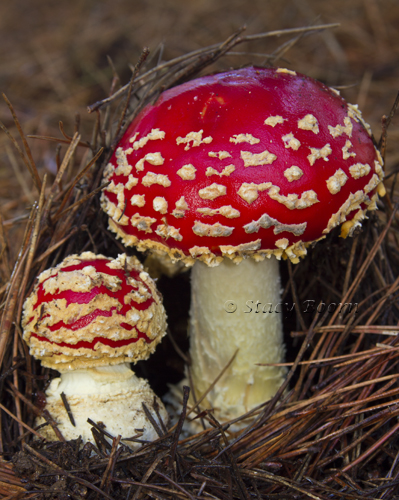Mushroom handbooks usually include a sentence or two with this warning: Never eat a mushroom unless you are absolutely certain of its identification. I assume that doesn’t include those served in restaurants or bought in the grocery stores where they have already been scrutinized for edibility.
So you begin identification by answering the question, “Does it have a cap and a stem?â€Â I can usually make it that far but figuring out other characteristics that lead to accurate identification often elude me. Perhaps that is why I enjoy approaching fungi photography as an art rather than a science project.
I have started a new portfolio called Fungi Art. If you can identify those mushrooms that I have assigned only a number I will reward you with a matted mushroom image suitable for an 11×14 frame (or 16 x 20).
Mushrooms have seasonal rhythms which for many local varieties begin after the first fall rains. The part of the mushroom that we see is the fruiting body and much of the fungus remains underground. Once these fruiting bodies have released their spores they begin to decompose.
After I started looking for them my mycological journey has taken me to the woodlands and grasslands. I especially seek them out below coniferous and deciduous trees with which the mushrooms have a mycorrhizal relationship. The tree gives the mushroom sugar and the mushroom gives the tree water and nutrients. (A specific tree supplies certain fungi with what they need to survive. So knowing the names of trees also becomes important because some mushrooms relate to specific trees.)
We have much to learn from the trees and their relationship with the mushrooms!
There are many other fungus types: club-shaped, rounded, skin-like, cup-shaped, coral-like, cage-like and several other shapes.
Curves and lines, shapes and shadows, colors and contrasts are some of the aspects helpful in creating dynamic fungus images. My basic method is to mount my Canon 7D on a tripod whose legs will go flat to the ground. This choice of camera provides a pop up flash which I engage for fill flash.
First I read the meter for the shutter speed needed for my chosen f-stop. I choose my f-stop so I have maximum control over depth of field. For many shots I want most or my entire mushroom in focus. Although, as in the case of the Orange Latex Lactarius I am willing to let some of the gills be slightly out of focus so that the background will not have details in it.
After I have my meter reading I turn my mode dial to manual and enter that f-stop and shutter speed. This way I can pop up the flash and get the ambient lighting for the overall scene and add a little light into the shadowed areas. Otherwise when using a full flash, with a set shutter speed like 1/60th of a second your light emitted from your flash will be such that it cannot illuminate your background and you will always have a black background. Also I use a $15 diffuser square that sits in front of the flash preventing harsh shadows.
Yes, we have much to learn from the mushrooms and their relationship with the trees. May we be so friendly and dependent on one another as we enter these holy days and a new year!



